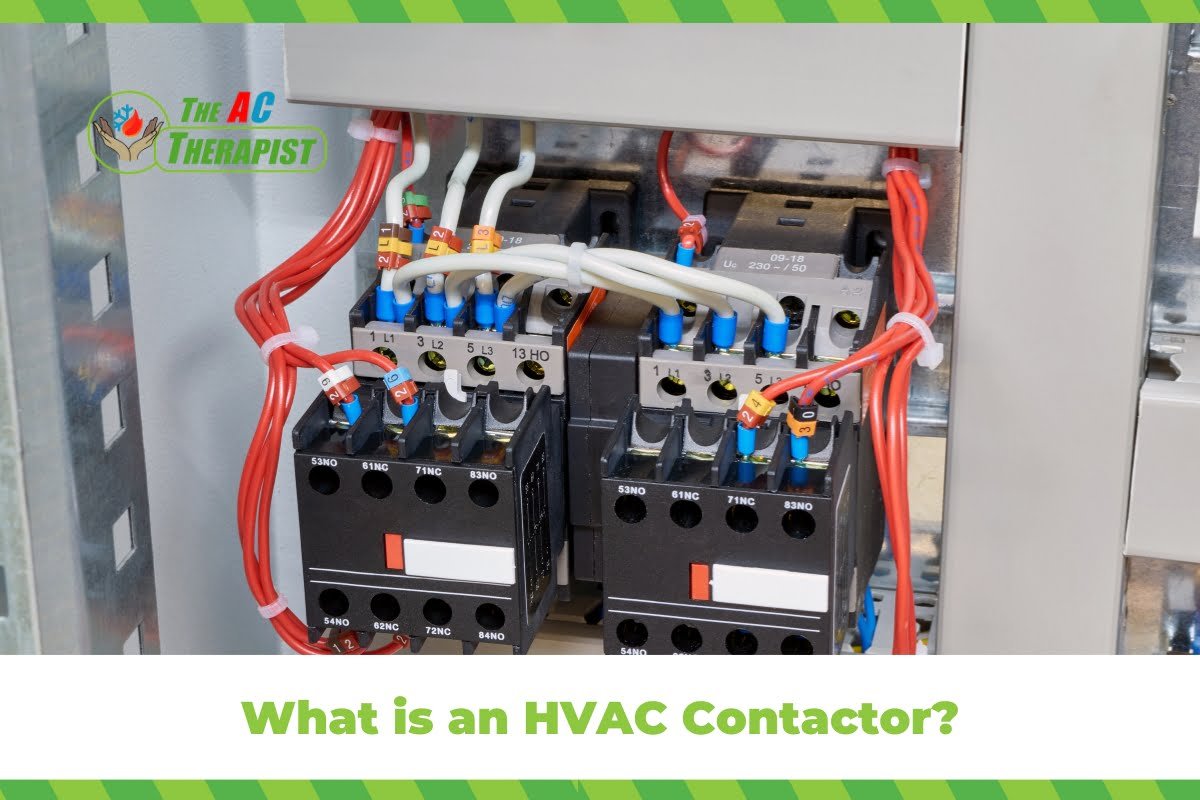What is an HVAC Contactor?
If you’re like most homeowners, you probably haven’t given much thought to the inner workings of your HVAC system. We’re quick to notice when the air conditioning isn’t cold enough, or when the furnace is acting up, but the intricate components that make everything work often go unnoticed. One such critical part is the HVAC contactor, a device that can make or break your home’s comfort levels. Understanding this crucial component can help you troubleshoot issues and even improve the efficiency of your system. In this comprehensive guide, we’ll explore what an HVAC contactor is, how it functions, why it’s vital, and signs that it may be time for a replacement.
An HVAC contactor is an electrically controlled switch used for your HVAC unit to start the high-power electrical load. It acts as a middleman, controlling the flow of electricity to various parts of your HVAC system, such as the compressor, the fan motor, and the blower. Essentially, it’s a bridge that allows the high-voltage components to operate safely and efficiently. When you adjust your thermostat, it signals the contactor to turn on or off, enabling or disabling the electrical flow to your heating or cooling system.
Types of HVAC Contactors
There are mainly two types of HVAC contactors:
Single Pole Contactors
Basic Features
Single pole contactors are simpler in construction and are widely used in residential HVAC systems. They feature one set of electrical contacts that close when the coil is energized by the low-voltage control circuit.
Applications
Typically, these contactors are employed for controlling single-phase applications, primarily the compressor in an air conditioning unit. In heating systems, they may be used to control electric furnaces or heat strips.
Advantages
- Cost-Effective: Generally less expensive than double pole contactors.
- Simpler Wiring: Easier to install and troubleshoot due to fewer contact points.
Disadvantages
- Limited Control: Can only manage one electrical circuit, making them unsuitable for more complex systems.
Double Pole Contactors
Basic Features
Double pole contactors are more complex and are commonly used in commercial HVAC systems, although they can be found in more advanced residential systems as well. They have two sets of electrical contacts, and they can control two electrical circuits simultaneously when the coil is energized.
Applications
These are generally used in systems that require simultaneous control of two separate high-power circuits. For example, in an HVAC system, a double pole contactor may control both the compressor and the condenser fan.
Advantages
- Greater Flexibility: Capable of controlling multiple circuits simultaneously.
- Better for Complex Systems: Suitable for commercial and industrial applications where multiple high-power circuits need to be controlled.
Disadvantages
- Cost: Generally more expensive than single pole contactors.
- Complexity: Requires more intricate wiring, making installation and troubleshooting potentially more challenging.
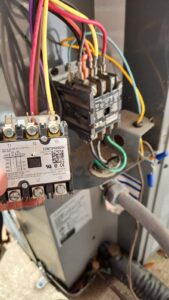
Signs of a Failing HVAC Contactor
In the intricate landscape of your HVAC system, the contactor plays a vital role. This electrical component acts as a bridge, connecting your thermostat to the high-voltage elements like the compressor, blower, and fan motor. When everything is working perfectly, you probably won’t even know it’s there. However, when your HVAC contactor starts to fail, the signs can be subtle but disruptive, affecting not just your comfort but also your safety and energy bills. Below are some telltale symptoms to watch out for that may indicate your HVAC contactor is on the fritz.
- Intermittent or Failed Start: One of the most noticeable signs of a failing contactor is when your HVAC system has trouble starting up or frequently stops working. This may manifest as your air conditioner or furnace turning on and off intermittently or not starting at all. The erratic behavior can usually be traced back to the contactor failing to make a proper electrical connection, disrupting the entire HVAC system.
- Unusual Noises: You might start hearing unusual noises from your HVAC unit, such as clicking or humming sounds. A fully functioning HVAC contactor will usually make a subtle “click” when engaging. However, if you hear a continuous clicking or humming noise when the system is supposed to be on or off, it could indicate that the contactor is not engaging or disengaging properly.
- Physical Damage: If you’re handy and comfortable doing so, you can visually inspect the contactor for any signs of wear and tear. With the power turned off, open the HVAC unit’s access panel and locate the HVAC contactor. Look for signs like charring, pitting, or any visible electrical arcing on the contact points. These are clear indicators that your contactor needs immediate replacement.
- Overheating: A failing contactor can sometimes cause the HVAC unit to overheat, resulting in a burnt smell. In extreme cases, this can lead to a potential fire hazard, emphasizing the importance of timely repair or replacement.
- High Electricity Bills: If your HVAC system seems to be running non-stop but isn’t effectively cooling or heating your home, it could be due to a HVAC contactor that is stuck in the “closed” position. This means that electricity is continuously flowing to the high-voltage components, causing your system to run incessantly and increasing your energy bills.
- Age and Lack of Maintenance: Like any other mechanical part, HVAC contactors have a finite lifespan, usually around 100,000 cycles (a cycle is a complete on-and-off sequence). If your HVAC system is old and the contactor has never been replaced, it might be nearing the end of its lifecycle. Regular maintenance checks can help identify this issue before it leads to system failure.
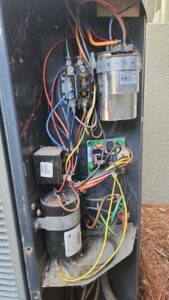
Importance of the HVAC Contactor
The HVAC contactor plays a pivotal role in the functioning of your heating, ventilation, and air conditioning system. Here’s why it is so important:
Safety
The contactor acts as a bridge between the low-voltage and high-voltage components in your HVAC system. When the thermostat sends a signal to activate the HVAC system, the contactor is responsible for allowing the high voltage to flow to components like compressors and motors. This helps to manage high electrical loads safely, reducing the risk of electrical surges, short circuits, and even potential fire hazards.
System Efficiency
A functioning contactor is crucial for the efficient operation of an HVAC system. It ensures that electrical current only flows when it’s needed, thereby preventing wasteful consumption of electricity. When a contactor starts failing, it can lead to a continuously running system, which will undoubtedly affect your electricity bill adversely.
Longevity of the System
The contactor also plays a significant role in enhancing the longevity of your HVAC system. By managing the electrical loads that go to the different components, it ensures that there’s minimal wear and tear on these high-voltage parts. A failing contactor can lead to overloads or incomplete electrical circuits, both of which can reduce the lifespan of your HVAC system significantly.
Comfort
Your HVAC system’s primary purpose is to keep you comfortable, be it via cooling in hot weather or heating in cold weather. If the contactor fails, the HVAC system can malfunction, leading to discomfort due to temperature irregularities. Thus, a fully functional contactor is crucial for maintaining a comfortable living environment.
Control
The contactor allows for the controlled flow of electrical current, as directed by the thermostat or other control systems. This precise control enables the HVAC system to respond correctly to your comfort needs, whether that’s turning on the air conditioner or the heating system. A faulty contactor will disrupt this control, leading to an unreliable HVAC system.
Cost Savings
A well-functioning contactor contributes to cost savings in multiple ways. First, by enabling efficient operation, it helps keep electricity bills in check. Second, minimizing wear and tear on other components, it reduces the frequency and cost of repairs or replacements.
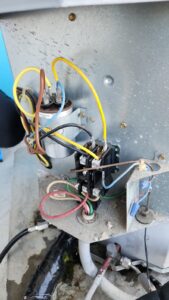
HVAC contactor replacement
Replacing an HVAC contactor is a critical task that should ideally be done by professionals, especially if you’re not experienced with electrical work. The contactor is responsible for regulating the flow of electricity to different components of your HVAC system, and a faulty installation can lead to a host of problems, from system failure to potential safety hazards. Here is a general overview of the replacement process:
What You’ll Need
- New HVAC contactor (of the same type as your old one)
- Screwdriver set
- Multimeter
- Insulated gloves
- Wire strippers (if necessary)
Safety First
- Turn off the electricity to your HVAC system at the circuit breaker.
- Use a multimeter to confirm there’s no electrical current flowing to the HVAC unit.
Steps to Replace an HVAC Contactor
- Open the Access Panel: Unscrew and remove the HVAC unit’s access panel to locate the contactor.
- Inspect Old Contactor: Examine the existing contactor for signs of wear and tear like charring, pitting, or arcing.
- Take Photos: Before disconnecting anything, take a few pictures of the existing setup to serve as a reference for reinstalling wires.
- Disconnect Wires: Mark the wires with tape and labels so you can remember where they go. Then, using a screwdriver, carefully disconnect the wires from the old contactor.
- Remove Old Contactor: Unscrew the mounting screws securing the old contactor in place, and remove it.
- Install New Contactor: Mount the new contactor in the same spot, using the screws. Make sure it is aligned and secure.
- Reconnect Wires: Refer to the photos you took earlier and reconnect the wires to their appropriate terminals on the new contactor.
- Test the Connection: With the panel still open and your gloves on, turn the power back on and activate your HVAC system via the thermostat to make sure the contactor is operating as it should.
- Close the Access Panel: If everything is functioning correctly, turn off the power again, secure any loose wires, and screw the access panel back into place.
- Restore Power: Turn the electricity back on at the circuit breaker.
- Final Test: Conduct a final test to make sure everything is working smoothly. It might be wise to monitor the system for a few days to ensure consistent operation.
Important Note
While DIY replacement is possible, it’s always recommended to consult or hire a professional HVAC technician for such tasks, especially if you’re not comfortable working with electrical components. Faulty installation can lead to inefficiency, and system breakdowns, and can be a potential safety hazard.
How do you know if your HVAC contactor is bad?
Identifying a bad HVAC contactor is crucial for maintaining an efficient and safe HVAC system. Here are some signs that your contactor may be failing or has already failed:
Visual Inspection
- Physical Damage: If you see visible signs of wear and tear, like charring or pitting on the contact points, it’s likely that the contactor needs replacement.
- Coil Condition: A burnt-out coil can be a sign of a bad contactor. In some cases, the coil may appear damaged or even melted.
Auditory Indicators
- Chattering or Buzzing Sounds: If you hear unusual noises like chattering or buzzing coming from your HVAC unit, this could be a sign that the HVAC contactor is failing to make or maintain proper electrical contact.
- Silence When Activating: If you don’t hear the characteristic “click” when the system turns on, the contactor may not be engaging as it should.
Performance Issues
- HVAC Doesn’t Turn On: If the HVAC system doesn’t turn on at all, it may be due to a contactor that is failing to close and complete the electrical circuit.
- HVAC Doesn’t Turn Off: Conversely, if the system runs continuously and won’t turn off, the contactor may be stuck in the closed position.
- Inconsistent Operation: If the HVAC system is acting erratically, turning on and off unexpectedly, it might be a sign of a failing contactor.
Electrical Tests
- Voltage Readings: You can use a multimeter to check for voltage across the contactor’s coil. A zero reading could indicate a bad coil, while inconsistent readings could signify a failing contactor.
- Resistance Measurements: Measuring the resistance across the coil terminals can also provide clues. A very high or infinite resistance reading suggests a bad coil.
Increased Energy Bills
An inefficiently running HVAC system due to a bad HVAC contactor can lead to increased energy consumption, which you may notice in your utility bills.
If you notice any of these symptoms, it’s advisable to consult a professional for diagnosis and replacement of the HVAC contactor. Replacing a bad contactor promptly can prevent further damage to your HVAC system and save you money in the long run.
What is the difference between a contactor and a relay?
Contactors and relays are both electrical switching devices, but they serve different purposes and are used in different contexts. Here are some key differences between the two:
Function
- Contactor: Primarily used to control high-current loads, typically above 15-20 amperes. They are commonly used in HVAC systems, industrial applications, and high-power electrical systems.
- Relay: Used for lower power applications where the controlled circuit and the controlling circuit are electrically isolated from each other. Relays are typically used in electronics, automotive systems, and low-power applications.
Construction
- Contactor: Generally more robustly built to handle higher current loads. They often have built-in features like arc suppression to handle the higher currents safely.
- Relay: Usually smaller and less robust than contactors. They don’t typically include features like arc suppression, as they are not designed for high-current loads.
Voltage
- Contactor: Designed to handle high-voltage applications, often up to several thousand volts.
- Relay: Generally used in low to medium-voltage applications, usually up to 250 volts.
Coil Energization
- Contactor: Often designed with a holding circuit that keeps the device closed as long as power is applied, reducing wear and tear.
- Relay: Generally lacks a holding circuit and must be continuously energized to remain in the closed position, which can lead to quicker wear and tear.
Number of Contacts
- Contactor: Usually has multiple contacts for handling complex or multi-phase loads.
- Relay: Generally has fewer contacts, and is often used for single-phase applications.
Cost
- Contactor: Usually more expensive due to their robust construction and additional features.
- Relay: Generally cheaper because of their simpler design and lower current handling capabilities.
User Interface
- Contactor: Often has manual control interfaces that allow for manual opening and closing of the contacts.
- Relay: Usually does not have manual control options, although there are exceptions.
Applications
- Contactor: Common in industrial settings, HVAC systems, and anywhere high-current machinery needs to be controlled.
- Relay: Common in consumer electronics, automotive systems, and general low-power electrical circuit control.
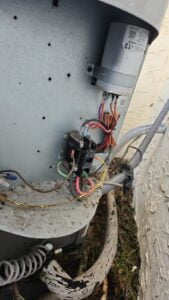
Final Thoughts: Why Understanding Your HVAC Contactor Matters and How We Can Help
Understanding the role of an HVAC contactor in your system is crucial for maintaining a comfortable, efficient, and safe living environment. As the bridge between your thermostat’s low-voltage signals and the high-voltage components like compressors and motors, the contactor is undeniably one of the linchpins of your HVAC system.
If you suspect your contactor is failing or has failed, it’s not a situation to take lightly. Issues with the contactor can lead to more severe problems, higher energy bills, and even safety concerns. That’s why it’s always a good idea to consult a professional for diagnosis and replacement.
At The AC Therapist, we specialize in HVAC services, including contactor replacement. Our expert technicians are trained to identify issues swiftly and carry out replacements efficiently, ensuring that your home returns to that state of “bliss” as quickly as possible.
Remember, your HVAC system is a significant investment and the backbone of your home’s comfort. Keeping it in peak condition starts with understanding its critical components. Stay cool, stay warm, and most importantly, stay informed!
For all your HVAC needs, including contactor replacement, we’re just a call away.
The AC Therapist – Your go-to expert for all things HVAC.

